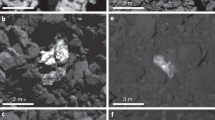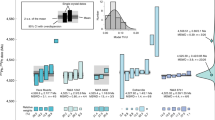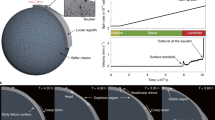Abstract
Basaltic asteroids are small bodies connected to the processes of heating and melting that may have led to the mineralogical differentiation in the interiors of the largest asteroids. Therefore, a precise knowledge of the inventory of basaltic asteroids may help to estimate how many differentiated bodies actually formed in the asteroid Main Belt and this in turn may provide important constraints to the primordial conditions of the solar nebula. The identification of basaltic asteroids in the asteroid Main Belt and the description of their surface mineralogy are necessary to understand the diversity in the collection of basaltic meteorites. In this work the current work of our team is presented: (i) The mineralogical characterization of the Vesta family members; (ii) The search of new basaltic asteroids in the Main Belt. In the first case, the objective is to characterize the material excavated from the craterization event/s in the crust of Vesta. This work is related to the possible findings of DAWN mission when it arrives to Vesta in 2011. In the second case, the objective is to find the link between the diversity of basaltic material in the meteorite collection and the asteroids.
Similar content being viewed by others
1 Introduction: The Basaltic Material
Basaltic asteroids are associated with the crust of a differentiated body, characterized by a Vesta (V-type) type spectrum. Historically, all V-type asteroids are assumed to come from Vesta and some facts helped to understand that assumption: (i) the identification of a Vesta dynamical family (Williams 1989; Zappalá et al. 1990) (ii) the confirmation of small basaltic asteroids in the region near (4) Vesta (Binzel and Xu 1993; Burbine et al. 2001); (iii) the identification of a large impact basin on (4) Vesta (Thomas et al. 1997); (iv) and the discovery of several basaltic near Earth asteroids (NEAs) (McFadden et al. 1985; Cruikshank et al. 1991; Binzel et al. 2004; Duffard et al. 2006a). It’s necessary to be mentioned that there are some small asteroids, identified with a V-type spectra, out of the nominal definition of the Vesta family but in the region. Its known that a relatively large fraction of the original Vesta family members may have evolved out of the family borders defined by clustering algorithms and are now dispersed over the inner asteroid belt. The dispersion mechanisms could be the Yarkosky effect and high orders dynamical resonances. In a recent work, Nesvorný et al. (2008) dynamically modeled the region of Vesta and showed that the efficiency of the dynamical processes studied is apparently not sufficient to link all known V-type inner-belt asteroids to the Vesta family. For example, they were unable to explain the large population of V-type objects with low-inclination orbits. The low-inclination V-type asteroids can be chunks of basalt from differentiated bodies other than Vesta that populated the region (or adjacent regions) in the past. Motivated by this scientific problem Duffard et al. (2004) performed a comparative spectroscopic study of V-type asteroids in the inner Main Belt. They found that there exists no apparent systematic difference in the inferred mineralogies of the Vesta-family and non-family V-type asteroids. Although non-conclusive, because mineralogies of different differentiated objects may be roughly similar, Duffard et al. (2006b) interpreted the observed variation in mineralogies as a function of the excavation depth from Vesta rather than proposing a distinct source for the low-i V-type population.
In conclusion, nothing is still conclusive in the inner belt and all these evidence open the door to the possibility of more differentiated objects in the early Solar System.
On the other hand, the discovery of a small basaltic asteroid, (1459) Magnya (Lazzaro et al. 2000) in the outer Main Belt pointed out the possibility of another source of basaltic material. On ground, meteorites called Howardite-Eucrite-Diogenite (HED) have similar V-type spectra and, again, were believed to come all from the asteroid (4) Vesta. Recently, different HED meteorites, like NWA011 and Ibitira (Yamaguchi et al. 2002; Wiechert et al. 2004) were identified, using the oxygen isotope technique, to come from other parent body than HED’s.
Another group of meteorites, the irons, indicates that they would come from the iron core of dozens of differentiated parent bodies. Many iron meteorite parent bodies formed and fragmented in the same region where we can find the interior planets Mercury, Venus, Earth and Mars. In this region, planetesimal accretion is faster and hence differentiation is more likely to occur among small bodies (Bottke et al. 2006). Finally, there are the primitive achondrite meteorites, representing the parent bodies of the Angrites, Mesosiderites and Urelites. In conclusion, at least there are seven different parent differentiated bodies represented in our achondrite meteorite collection, plus the iron meteorite sample. However, there are very few olivine-rich meteorites and asteroids (classified as A-type) which are assumed to come from the mantle of differentiated bodies. The study of the mantle in a differentiated object was the point in the work presented on A-type asteroid Lick (de León et al. 2004). It was determined the composition of the olivine present in the surface of the asteroid analyzing the reflectance spectra of the surface.
More work in searching and identifying A-type asteroids is in urgent need. The material from the mantle of the mentioned differentiated objects need to be out there.
In a previous work (Duffard and Roig 2009) we presented the discovery of two new basaltic asteroids in the outer Main Belt. Our results indicate that, together with (1459) Magnya, asteroids (7472) Kumakiri and (10537) 1991 RY16 may be the only traces of basaltic material found up to now in the outer Main Belt. These asteroids may come from different parent bodies and not from Vesta itself. Due to the size of these objects, less than 30 Km, all of them must be fragments of a bigger object’s crust. The region with similar orbital parameters to these asteroids is a interesting zone to find more V-type, A-type or iron type asteroids, products of the collisional fragmentation of the original parent body.
2 Current Work
In this context, we are carrying a research in basaltic material in the Solar System with the main objective to understand the formation of the terrestrial planets. As a first case, we are studying the Vesta family members, including V-type asteroids in the region (between 2.2 and 2.5 AU). This study is not only a spectroscopic mineralogical characterization but a photometric survey of the family members. Determining the rotational period, shape, possible new binaries and the mineralogy of the fragments coming from the crust of Vesta will allow us to understand the interior of the body. Light-curves of the family members are been taken in the last 2 years in several 2 m class telescopes. From these measurements it’s possible to obtain the rotational period, the estimated shape and possibility of binarity to final estimate the densities as was done in (Ryan et al. 2004). Visible and near infrared spectra are obtained in different telescope and after a mineralogical characterization it’s possible to extrapolate the results to go deep into the crust of Vesta (Duffard et al. 2004, 2006a; Canas et al. 2008). The DAWN mission, arriving at Vesta in 2011, will map (image and spectra) the whole surface of the asteroid. The family members are fragments ejected in the collision that formed the huge crater pictured by the Hubble Space Telescope (Thomas et al. 1997). In other words, studying the family members we are obtaining information about the deeper layers of Vesta’s crust. At the end, we will compare the results obtained by the DAWN instruments on the Vesta surface with the fragments from deeper layer of the basaltic crust. This is an excellent example of studying rocks from inside an asteroid or a planet. At the same time, it’s necessary to continue in the study of the V-type asteroids outside the family. As they have a particular spectral feature, easy to identify, its possible to use this material as a “marker” to know the dynamical processes present in the region. Searching and finding more V-type objects outside the family could help to understand the local resonances that could transport material from a collision on Vesta. All this is true if it’s assumed that all the V-type material is from that asteroid.
The other possibility is the presence of other differentiated object in the region that was completely destroyed, and the consequences of that collision must be observable today. If this assumption is true, not only V-type asteroids (from the crust), but olivine type material (from the mantle) and iron material from the nucleus must be found.
On the other hand, following the evidences that shows the presence of basaltic material other than pieces of Vesta’s, we continue the search of basaltic material. The more interesting place to find new basaltic material is the middle/outer main asteroid belt. The region of the inner belt related with Vesta is not less important. Same basaltic objects in that region, but outside the nominal dynamical Vesta’s family (Fig. 1), are difficult to be explained by dynamical transportation from Vesta. Some interesting works were done at this respect (Carruba et al. 2005, 2007) trying to explain the particular example of (21238) 1995 WV7 which is in the other side of the 3:1 mean motion resonance.
Semimajor axis versus eccentricity showing the Vesta dynamical family (small dots), V-type asteroids outside the Vesta family spectroscopically identified (squares) and the V-type candidates identified from Roig and Gil-Hutton 2006, using the SLOAN survey (triangles). The SLOAN candidates in the middle/outer main belt spectroscopically confirmed are marked
Using the SLOAN photometric survey, as explained in Roig and Gil-Hutton (2006) and Duffard and Roig (2009), we continue to identify spectroscopically the objects pointed out by this technique. The actual map showing the objects identified by the SLOAN survey and the ones identified with a visible spectrum are shown in Fig. 1. The technique showed to be 100% efficient, all the objects in the middle/outer belt identified as basaltic using the Roig and Gil-Hutton paper were confirmed as V-type (Roig et al. 2008; Duffard and Roig 2009) in the visible (0.5–0.9 microns) range.
An extra objective of our work is to spectroscopically identify a differentiated family. That is, an asteroid family created by the disruption of a differentiated body. In this case, the family members must show mineralogical signatures of fragments coming from the crust, mantle and nucleus of the differentiated parent body. Some works start to appear showing olivine-type family members, that is material from the mantle of a differentiated body, in the Eos family (Mothé-Diniz et al. 2008).
3 Discussion
What do we expect to see when DAWN arrives at Vesta? We know that mineralogical variations do exist on Vesta (Gaffey 1997; Binzel et al. 1997) and elemental and mineral compositions will be characterized. We will know how are these compositions and rock types linked to geologic processes on a body of the size of Vesta. Our studies are oriented to help understand if the stratigraphy/structure of Vesta’s crust and mantle can be reconstructed.
The main point of all this work is that 10 years ago, the only known differentiated asteroid was Vesta, and today several clues points to many others differentiated objects. There are several basaltic asteroid in the middle/outer belt not related with Vesta. There are several V-type asteroids in the region of Vesta, outside the nominal family, that are difficult to explain the dynamical transportation from Vesta, if they came from it. The alternative option is to accept the presence of another differentiated object in the region that was completely destroyed in a collision. If this is true, it’s in urgent need to find other evidences of that collision, that is, asteroids in the region with spectroscopic features consistent with parts of the crust, the mantle and the nucleus of that object.
The meteorite samples, irons and achondrites, shows that more than 20 differentiated parent bodies were present in the early Solar System. The importance of identifying the differentiated parent bodies is that the terrestrial planets need to be formed from differentiated smaller objects. Bodies of the size of Vesta are differentiated in 3–4 Myr, Mars size bodies in 10–15 Myr and Earth like bodies in 30 Myr (Kleine et al. 2002). The main heater in the initial stages of formation in the Solar System is the 26Al, which has a lifetime of only 0.7 Myr. The formation of Vesta like bodies is possible in the first 5 Myr but Earth like bodies need to be formed from differentiated planetesimals otherwise the quantity of 26Al was not enough to heat and melt a big object like Mars or the Earth. Isotopic chronometers also indicate that core formation among iron meteorite parent bodies occurred 1–2 Myr before the formation of the ordinary chondrite parent bodies (Bizzarro et al. 2005). All these heating processes occurred really soon in the formation of the Solar System and can give us clues on that time of formation in our and other planetary discs.
References
R.P. Binzel, S. Xu, Chips off of Asteroid 4 Vesta: evidence for the parent body of basaltic achondrite meteorites. Science 260, 186–191 (1993)
R.P. Binzel, M.J. Gaffey, P.C. Thomas, B.H. Zellner, A.D. Storrs, E.N. Wells, Geologic mapping of Vesta from 1994 Hubble Space Telescope images. Icarus 128, 95–103 (1997)
R. Binzel, A. Rivkin, S. Stuart et al., Observed spectral properties of near-Earth objects: results for population distribution, source regions, and space weathering processes. Icarus 170, 259 (2004)
M. Bizzarro, J.A. Baker, H. Haack, K.L. Lundgaard, Rapid timescales for accretion and melting of differentiated planetesimals inferred from 26Al–26Mg chronometry. Astrophys. J. 632(1), L41–L44 (2005)
W.F. Bottke et al., Iron meteorites as remnants of planetesimals formed in the terrestrial planet region. Nature 439, 821–824 (2006)
T.H. Burbine, P.C. Buchanan, R.P. Binzel, S.J. Bus, T. Hiroi, J.L. Hinrichs, A. Meibom, T.J. McCoy, Vesta, vestoids, and the howardite, eucrite, diogenite group: relationships and the origin of spectral differences. Meteorit. Planet Sci. 36, 761–781 (2001)
L. Canas, R. Duffard, T. Seixas, Mineralogy of HED meteorites using the modified Gaussian model. Earth Moon Planets 102(1–4), 543–548 (2008)
V. Carruba, T.A. Michtchenko, F. Roig, S. Ferraz-Mello, D. Nesvorný, On the V-type asteroids outside the Vesta family. I. Interplay of nonlinear secular resonances and the Yarkovsky effect: the cases of 956 Elisa and 809 Lundia. Astron. Astrophys. 441, 819–829 (2005)
V. Carruba, T.A. Michtchenko, D. Lazzaro, On the V-type asteroids outside the Vesta family. II. Is (21238) 1995 WV7 a fragment of the long-lost basaltic crust of (15) Eunomia? Astron. Astrophys. 473, 967–978 (2007)
D.P. Cruikshank, D.J. Tholen, J.F. Bell et al., Three basaltic earth-approaching asteroids and the source of the basaltic meteorites. Icarus 89, 1–13 (1991)
J. de León, R. Duffard, J. Licandro, D. Lazzaro, Mineralogical characterization of A-type asteroid (1951) Lick. Astron. Astrophys. 422, L59–L62 (2004)
R. Duffard, F. Roig, Two new V-type asteroids in the outer Main Belt? Planet Space Sci. 57, 229–234 (2009)
R. Duffard, D. Lazzaro, J. Licandro, M.C. de Sanctis, M.T. Capria, J.M. Carvano, Mineralogical characterization of some basaltic asteroids in the neighborhood of (4) Vesta: first results. Icarus 171(1), 120–132 (2004)
R. Duffard, J. de León, J. Licandro, D. Lazzaro, M. Serra-Ricart, Basaltic asteroids in the near-Earth objects population: a mineralogical analysis. Astron. Astrophys. 456, 775–781 (2006a)
R. Duffard, D. Lazzaro, J. Licandro, M.C. de Sanctis, M.T. Capria, V-type asteroids: a mineralogical study. Adv. Space Res. 38(9), 1987–1990 (2006b)
M.J. Gaffey, Surface lithologic heterogeneity of Asteroid 4 Vesta. Icarus 127, 130–157 (1997)
T. Kleine, C. Münker, K. Mezger, H. Palme, Rapid accretion and early core formation on asteroids and the terrestrial planets from Hf-W chronometry. Nature 418(6901), 952–955 (2002)
D. Lazzaro, T.A. Michtchenko, J.M. Carvano et al., Discovery of a basaltic asteroid in the outer Main Belt. Science 288, 2033–2035 (2000)
L. McFadden, M.J. Gaffey, T. McCord, Near-earth asteroids: possible sources from reflectance spectroscopy. Science 229, 160–163 (1985)
T. Mothé-Diniz, J.M. Carvano, S.J. Bus, R. Duffard, T.H. Burbine, Mineralogical analysis of the Eos family from near-infrared spectra. Icarus 195, 277–294 (2008)
D. Nesvorný, F. Roig, B. Gladman, D. Lazzaro, V. Carruba, T. Mothé-Diniz, Fugitives from the Vesta family. Icarus 193, 85–95 (2008)
F. Roig, R. Gil-Hutton, Selecting candidate V-type asteroids from the analysis of the Sloan Digital Sky Survey colors. Icarus 183, 411–419 (2006)
F. Roig, D. Nesvorný, R. Gil-Hutton, D. Lazzaro, V-type asteroids in the middle Main Belt. Icarus 194, 125–136 (2008)
W.H. Ryan, E.V. Ryan, C.T. Martinez, 3782 Celle: discovery of a binary system within the Vesta family of asteroids. Planet Space Sci. 52(12), 1093–1101 (2004)
P.C. Thomas, R.P. Binzel, M.J. Gaffey et al., Impact excavation on asteroid 4 Vesta: Hubble Space Telescope results. Science 277, 1492–1495 (1997)
U.H. Wiechert, A.N. Halliday, H. Palme et al., Oxygen isotope evidence for rapid mixing of the HED meteorite parent body. Earth Planet. Sci. Lett. 221, 373–382 (2004)
J.G. Williams, Asteroid family identifications and proper elements, in Asteroids II, ed. by R.P. Binzel, T. Gehrels, M.S. Matthews (University of Arizona Press, Tucson, 1989), pp. 1034–1072
A. Yamaguchi, R.N. Clayton, T.K. Mayeda et al., A new source of basaltic meteorites inferred from Northwest Africa 011. Science 296, 334−336 (2002)
V. Zappalá, A. Cellino, P. Farinella, Z. Knezevic, Asteroid families. I. Identification by hierarchical clustering and reliability assessment. Astron. J 100, 2030–2046 (1990)
Author information
Authors and Affiliations
Corresponding author
Rights and permissions
About this article
Cite this article
Duffard, R. Basaltic Asteroids in the Solar System. Earth Moon Planet 105, 221–226 (2009). https://doi.org/10.1007/s11038-009-9306-y
Received:
Accepted:
Published:
Issue Date:
DOI: https://doi.org/10.1007/s11038-009-9306-y





